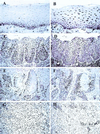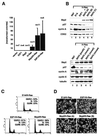Skp2 is oncogenic and overexpressed in human cancers
- PMID: 11309491
- PMCID: PMC33160
- DOI: 10.1073/pnas.081474898
Skp2 is oncogenic and overexpressed in human cancers
Abstract
Skp2 is a member of the F-box family of substrate-recognition subunits of SCF ubiquitin-protein ligase complexes that has been implicated in the ubiquitin-mediated degradation of several key regulators of mammalian G(1) progression, including the cyclin-dependent kinase inhibitor p27, a dosage-dependent tumor suppressor protein. In this study, we examined Skp2 and p27 protein expression by immunohistochemistry in normal oral epithelium and in different stages of malignant oral cancer progression, including dysplasia and oral squamous cell carcinoma. We found that increased levels of Skp2 protein are associated with reduced p27 in a subset of oral epithelial dysplasias and carcinomas compared with normal epithelial controls. Tumors with high Skp2 (>20% positive cells) expression invariably showed reduced or absent p27 and tumors with high p27 (>20% positive cells) expression rarely showed Skp2 positivity. Increased Skp2 protein levels were not always correlated with increased cell proliferation (assayed by Ki-67 staining), suggesting that alterations of Skp2 may contribute to the malignant phenotype without affecting proliferation. Skp2 protein overexpression may lead to accelerated p27 proteolysis and contribute to malignant progression from dysplasia to oral epithelial carcinoma. Moreover, we also demonstrate that Skp2 has oncogenic potential by showing that Skp2 cooperates with H-Ras(G12V) to malignantly transform primary rodent fibroblasts as scored by colony formation in soft agar and tumor formation in nude mice. The observations that Skp2 can mediate transformation and is up-regulated during oral epithelial carcinogenesis support a role for Skp2 as a protooncogene in human tumors.
Figures






References
-
- Sherr C J. Science. 1996;274:1672–1677. - PubMed
-
- Deshaies R J. Annu Rev Cell Dev Biol. 1999;15:435–467. - PubMed
-
- Koepp D M, Harper J W, Elledge S J. Cell. 1999;97:431–434. - PubMed
-
- Sutterlüty H, Chatelain E, Marti A, Wirbelauer C, Senften M, Müller U, Krek W. Nat Cell Biol. 1999;1:207–214. - PubMed
-
- Tsvetkov L M, Yeh K H, Lee S H, Sun H, Zhang H. Curr Biol. 1999;9:661–664. - PubMed
Publication types
MeSH terms
Substances
LinkOut - more resources
Full Text Sources
Other Literature Sources
Medical
Research Materials
Miscellaneous

